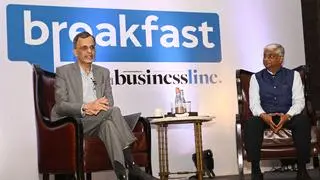The GDP growth estimate of 7.1 per cent for 2016-17 put out by the Central Statistics Office (CSO), barely changing from the earlier estimate (first advance estimate), has again flummoxed economists.
If the latest growth numbers are indeed credible, then the cash crunch after demonetisation has had no impact on economic growth.
But, aside from several weak links in the CSO’s estimate, the important point to note is that the current estimates mostly take into account data from the organised sector. Incorporating data from the informal sector, where the real impact of demonetisation was felt, will take a couple of months.
This could lead to subsequent revisions in the GDP growth number, which can be significant. The CSO only recently revised growth numbers for 2015-16 substantially. So we might have to wait for a year to assess the real impact of demonetisation.
While the new GDP incorporates more comprehensive data on corporate activity, using annual accounts of companies filed with the Ministry of Corporate Affairs (MCA21), much of the data on the informal sector for now is based on the Index of Industrial Production (IIP) numbers, according to economists. The GDP growth estimates could hence be revised down as real data on the unorganised sector flows in.
According to Aditi Nayar, Principal Economist, ICRA, “since the early estimates of quarterly GVA rely heavily on available data from the formal sector ... the Q3 FY2017 GVA growth may not be fully capturing the impact of the note ban. Subsequent estimates that draw from wider data sources may well revise Q3 FY2017 growth downward”
According to a YES Bank report, the third provisional estimate due on May 31 will reveal the bulk of the impact.
The final estimate will be available only by January 2018, incorporating data from the unorganised segment. This will reflect the full impact of the ‘currency swap’ process on the economy says the report.
There is a possibility that some residual impact of demonetisation may also be felt in the fourth quarter, according to Suyash Choudhary, Head, Fixed Income, at IDFC Mutual Fund.
Corporate earnings serve as a proxy to the value-add arrived at while calculating the new GDP—gross value added (GVA).
Too optimisticWhile corporate results of listed companies have shown a marked improvement in earnings mainly due to a low base and some cost efficiencies, the CSO’s strong 8.3 per cent growth in manufacturing GVA for the third quarter of 2016-17 is still a tad too optimistic.
To grow by 7.7 per cent for the full year, manufacturing GVA will have to grow by 6.7 per cent in the Jan-March quarter.
Besides, if agriculture and public administration were excluded, then the slowdown in the pace of growth in the economy is clearly evident, says Suyash.
Excluding agriculture and public administration, Q3 GVA growth slipped to 5.7 per cent from 6.4 per cent in the previous quarter.
The ‘net taxes’ angleUnder the new series, the GVA is adjusted for subsidy (food or petrol) and indirect tax to arrive at the GDP number.
While the CSO’s GDP growth estimate for 2016-17 has remained unchanged from its earlier estimate, GVA growth has been revised down from 7 per cent to 6.7 per cent.
Correspondingly, growth in net taxes for products has been revised upwards, citing good growth in indirect taxes (24 per cent until January) and shrinkage of subsidies.
Interestingly, the difference between GDP growth and GVA growth has increased substantially to 70 basis points in Q2 of 2016-17; in 2015-16 the gap was just 10 basis points.








Comments
Comments have to be in English, and in full sentences. They cannot be abusive or personal. Please abide by our community guidelines for posting your comments.
We have migrated to a new commenting platform. If you are already a registered user of TheHindu Businessline and logged in, you may continue to engage with our articles. If you do not have an account please register and login to post comments. Users can access their older comments by logging into their accounts on Vuukle.